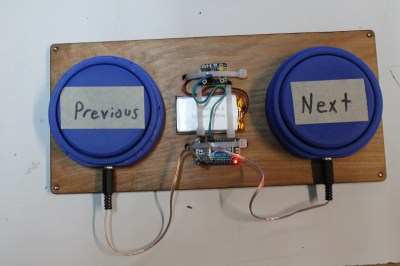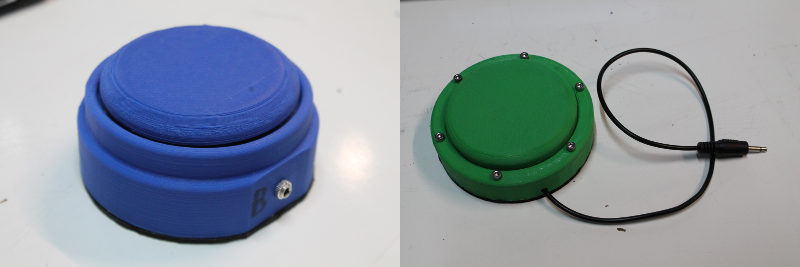An AT button is a device that helps people with all kinds of physical disabilities to interact with their world. There isn’t much to them, just a switch wired up to a 3.5mm mono plug or jack, but the switch is installed in a large button housing that’s easy to operate.
These buttons can be used with any appliance or toy that can be adapted for mono input. They’re a simple piece of technology that makes a world of difference, but for some reason, they cost around $65 each. Because of this, people make their own simple switches, but these aren’t usually sturdy or long-lasting. [Christopher] thinks they should cost way less than that and set out to make buttons for about $10 in materials. Aside from the printed files, all you really need to make a Clunke button is one Cherry MX in your favorite shade of blue, blue, or blue, and either a 3.5mm mono jack or plug, depending on preference.
 [Christopher] and his team devised the Clunke Button in collaboration with the local United Cerebral Palsy chapter as part of their senior design project. When it came time to present the project, they wanted to find a way to be able to pass a Clunke button around the audience and have it do something when pressed. They made an interactive ticker by adding an ESP-01 and a battery. [Christopher] has since taken over the project and continues to improve the design as he progresses through the Prize finals. Code for the ticker is available on GitHub, and the button STL files are on Thingiverse.
[Christopher] and his team devised the Clunke Button in collaboration with the local United Cerebral Palsy chapter as part of their senior design project. When it came time to present the project, they wanted to find a way to be able to pass a Clunke button around the audience and have it do something when pressed. They made an interactive ticker by adding an ESP-01 and a battery. [Christopher] has since taken over the project and continues to improve the design as he progresses through the Prize finals. Code for the ticker is available on GitHub, and the button STL files are on Thingiverse.





















http://www.arcadeshop.de/Illum-Buttons-Jumbo-Dome-Button-98-mm-red_505.html
Less then 10 euros… (in different colors)
If you’re not afraid of Asian wholesale, 100mm arcade dome buttons can be had for a little over $5/pc (or a little under €4.5/pc, I guess) in qty 5. (For those who prefer an American outlet, Adafruit has them for $10/pc.)
As much as I love them, the dome buttons aren’t ideal in this particular application. Being arcade buttons, their light and switch mechanisms extend a few cm below the panel. If mounted on that wood plank panel, the stalks would be poking into the user’s lap.
Yes, exactly! We need good guides for turning buttons like those into ones that work with these 3.5mm systems.
Clever
Staples “That was easy” buttons are pretty cheap.
They are. The one I owned back in high school didn’t seem like a good fit for this kind of adaptation though. The internal switch was a bent piece of metal that depressed a silicon pad.. Not really good for soldering to, though there may be easily accessed points on the little speaker PCB.
Getting a method that makes soldering the 3.5mm cable in easy, while also disabling the speaker would make those buttons work nicely as adaptive switches!
I can imagine an alternate version of this project that doesn’t use any 3D-printing and is fashioned mostly from stuff purchased at Dollar Tree (including the 3.5mm jacks).
Yes, for instance I’m fairly sure I’ve seen stick up LED dome lights in the dollar stores.
Definitely. Though there needs to be guides or something to help people reliably build assistive switches from those components.
The target audience for Clunke is hobbyists with 3D printers. Using parts from a local outlet would broaden that group to be most maker and hackerspaces.
What about the Echo buttons that Amazon recently released? They would be a good candidate for this if they were reverse engineered!
That sounds like a good idea, though I’ve never actually seen an Echo button in person. I’ll have to round one up and take a close look at it!